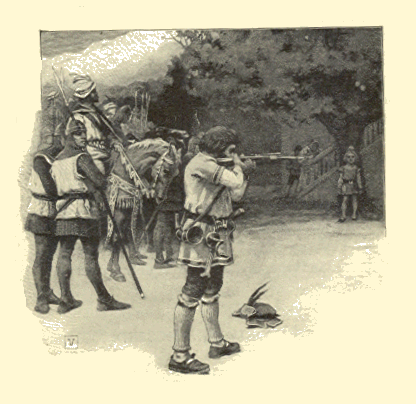This is about a way of working that is a mentality more than a specific technique. Above all, it is about awareness.
Accuracy is essential in woodworking – layout, cutting, surfacing, fitting, and so forth. We strive for this, perhaps even aiming for unattainable perfection, like a shooting at a bull’s-eye.
Consider William Tell, who, legend holds, was forced by a tyrant to take one attempt to shoot an arrow through an apple sitting on the head of the archer’s son. If he missed, the tyrant’s soldiers would kill the boy. Though he courageously took careful aim at the apple, surely Tell shot with the awareness that to miss low would kill his own son. If he missed high, at least there might be a Plan B to save his son. Fortunately he did not need to use the extra arrow under his coat, but one wonders what might have ensued if the first shot missed.
In woodworking, all inaccuracies are not equal. It is not like aiming at a concentric circle target. To do good work, one must be not only intent on hitting the mark but also cognizant of the consequences of the different directions of missing the mark. This awareness comes from understanding the significance of the task at hand and where it fits into the project as a whole.
This does not mean one should saw everything fat, nor does it excuse being timid about working to the line. It does mean that the concept of a one-sided tolerance can be applied to most woodworking tasks. Here it is: try to hit it right with an accuracy appropriate to the function of that part of the project, with an awareness that errors in some directions are less consequential (and perhaps fully tolerable) than errors in other directions which can seriously compromise the work.
As an example, in sawing a tenon, strive (courageously) to saw to the layout line but be aware that sawing it too thin is a considerably bigger nuisance to correct than sawing a bit too fat, which can be quickly remedied by paring or planing. In the bigger picture, you are aware that a loose tenon will compromise the strength of the structure. The same general idea can be applied to cutting dovetails, fitting drawers and doors, even flattening a board.
By contrast, you broaden your tolerances planing a chamfer with a block plane. If it looks about right, fine.
This is a much more effective approach than pursuing the illusion that you must or might get it “perfect.” Don’t believe the “perfect every time” promise in some woodworking ads and literature. It is neither necessary nor real.
Be always aware of: How does this process that I’m doing at the moment, fit in and affect the whole of the piece? (In this way, does art imitate life?)
With this approach, the craftsman works with ease and confidence. He does not pursue, nor is intimidated by, perfection. Rather he knows what he is after in reality and how to work effectively toward it. Put another way, the craftsman accepts his humanity, and does not fight it but rather works with it to function effectively. In this work of creativity, the craftsman is superior to any machine.



Machines can cut to “perfect” dimensions. However, It the craftsman who has to allow for the swelling or shrinking of the cut wood. Woodworking can remind you of your humanity very quickly.
Art happens when an overall intent is filtered through our abilities and moment to moment fortuities. The abstraction that occurs is perceived as expression and is what we react to as human and beautiful. Machines and assembly lines are not well suited to sincere abstraction in this regard.
I doubt we can say a priori that “timidity” spoils the work. It always remains to be seen whether the result is good or bad. In other words, a good chair is not made less so because the woodworker sawed fat and timidly chiseled the joints.